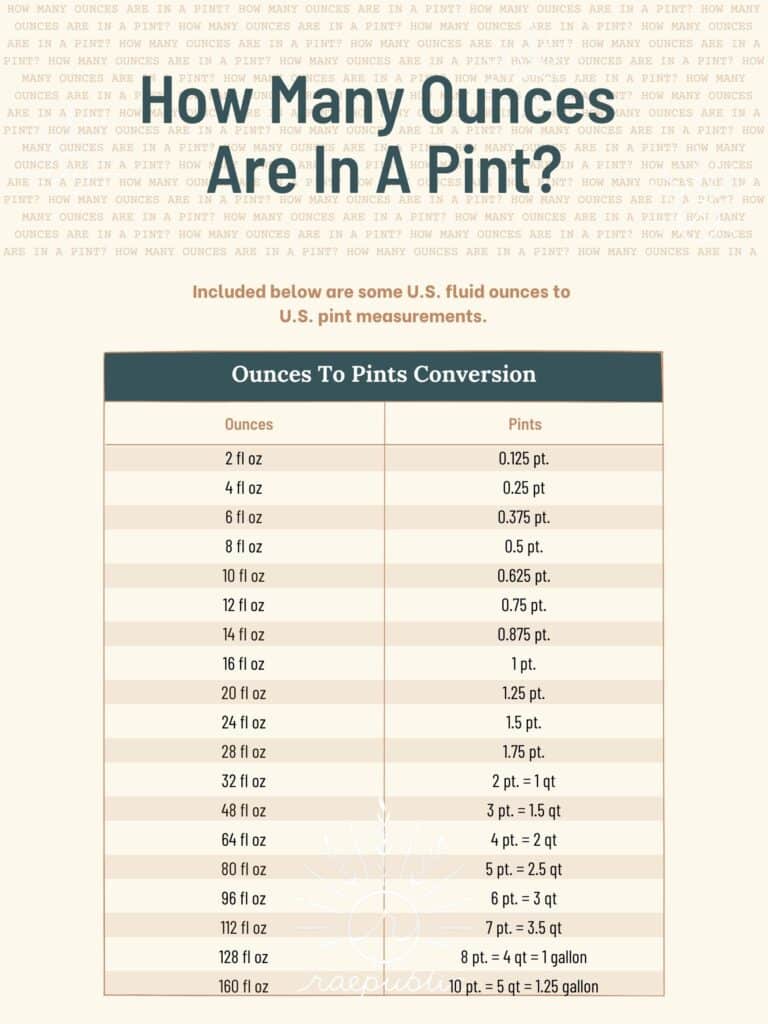Are you curious about the conversion between ounces and pints? Understanding how many ounces are in a pint is essential for various practical purposes. Whether you’re measuring ingredients for a recipe or estimating liquid quantities. In the United States, a pint contains 16 fluid ounces, but there’s more to know! Keep reading for an in-depth exploration of how many ounces are in a pint, along with valuable tips and informative conversion charts.
This post contains affiliate links.

What is a pint?
A pint is a unit of measurement used to quantify volume, particularly in the context of liquid substances. Its origin can be traced back centuries, and it has since become a widely recognized measurement in various parts of the world. In this section, we will delve into the history of the pint, its original uses, and its modern-day applications.
Historical Origins and Uses
The word pint finds its roots in the Latin word “pincta,” meaning painted. The pint was historically used to refer to a painted mark on a container that indicated a specific volume. The pint, an imperial measurement, was prevalent in medieval Europe, where it was used to measure various liquids, including ale, beer, and wine.
In different regions, the size of a pint varied. For instance, in England, the pint was standardized by King Henry VII in the 15th century. It was defined as the volume of 8 pounds of wheat, which was equal to 34.67743 cubic inches or approximately 568.26125 milliliters. This measurement became known as the “imperial pint” and is still used in the United Kingdom.
Modern-Day Usage
Today, the pint measurement continues to be widely used, particularly in countries that have historical ties to the United Kingdom, such as the United States. The American pint is legally defined as 16 fluid ounces, which is equivalent to approximately 473.176 milliliters. This measurement is often referred to as the “U.S. pint” or the “liquid pint” to differentiate it from the imperial pint.
The pint measurement is commonly used for various purposes. In the beverage industry, pints are frequently used to serve draft beer in pubs and bars. Pint-sized containers are also commonly used for selling bottled beverages, such as carbonated drinks, cider, and certain types of milk. Additionally, pints are often utilized to measure and sell liquid products like paints, cleaning solutions, and cooking ingredients.

Current Day Measurement Terms
UK Pint Terms
- British imperial system
- Imperial systems of measurement
- UK pint
- British pint
- English pints
American Pint Terms
- Standard pint measurement
- US fluid pints
- U.S. pints
- US liquid pint
- U.S. measurements
Common Abbreviations For Pint
Common abbreviations for pint include “pt” and “pt.”.
Comparison to the Metric System
In the metric system, the primary unit of volume measurement is the liter. One liter is equivalent to 1,000 milliliters or approximately 33.814 fluid ounces. Comparing the pint to the liter, the pint is smaller in volume. The U.S. pint is roughly 0.473 liters, while the imperial pint is approximately 0.568 liters. This discrepancy highlights the difference between the U.S. customary measurement system and the metric system commonly used in most parts of the world.
While the metric system offers advantages in terms of its decimal-based nature and ease of conversion between units, the pint measurement continues to be used in certain regions due to historical reasons and cultural traditions. It remains a familiar unit of measurement for many individuals, particularly in countries where the customary system is still prevalent.

What is an ounce?
The ounce is a unit of measurement commonly used to quantify weight or mass. It has a fascinating history that spans centuries, originating from ancient civilizations and evolving into its modern-day applications. In this section, we will explore the origins of the ounce, its original uses, and its relevance in contemporary society.
Historical Origins and Uses
The term “ounce” can be traced back to ancient Rome and Greece, where it was derived from the Latin word “uncia” and the Greek word “onza,” both meaning the twelfth part. The ounce was initially defined as one-twelfth of a pound and served as a convenient fraction for dividing larger quantities of weight.
Throughout history, various regions adopted their own definitions of the ounce, leading to slight variations in its size. For example, in ancient Greece, the ounce was known as the “Attic ounce” and was equal to approximately 28.3 grams. In contrast, the Roman ounce, also known as the “uncia,” equated to roughly 27.3 grams.
Modern-Day Usage
In modern times, the ounce has become a widely recognized unit of measurement, particularly in countries that utilize the customary system, such as the United States. It is predominantly used to measure the weight or mass of both solid and liquid substances.
The ounce is commonly employed in the culinary world, where precise measurements are crucial for recipes. Ingredients like flour, sugar, spices, and liquids are often measured in ounces. Additionally, the ounce is frequently used in the context of body weight and dietary guidelines and in the sale of food products, such as pre-packaged meats, cheese, and beverages.

Current Day Measurement Terms
UK Ounce Terms
- British imperial system
- Imperial systems of measurement
- Imperial fluid ounces
- British imperial ounces
American Ounces Terms
- U.S. measurements
- U.S. fluid ounces
Common Abbreviations For Ounces
The common abbreviation for ounce and ounces is “oz”.
Comparison to the Metric System
In the metric system, the gram is the primary unit of weight or mass measurement. One ounce is approximately equivalent to 28.35 grams, providing a basis for conversion between the customary system and the metric system.
Compared to the metric system, the use of ounces can sometimes lead to complexities and inconsistencies due to variations in definitions across regions. For instance, the fluid ounce, which measures volume, differs from the ounce used to measure weight or mass. In the United States, one fluid ounce is equivalent to approximately 29.57 milliliters, while in the United Kingdom, it is approximately 28.41 milliliters.
It is important to note that the ounce is still widely used in some industries and contexts, despite the metric system being more prevalent globally. The familiarity and practicality of the ounce measurement in specific regions, especially those with historical ties to the customary system, contribute to its continued usage.

How many ounces are in a pint?
In the United States customary system, there are 16 fluid ounces in a pint. This means that if you have a container holding a pint of liquid, it would equal 16 fluid ounces. It’s worth noting that the fluid ounce used for measuring volume is different from the ounce used for measuring weight or mass. However, when referring to a pint in the context of liquid measurements, it generally corresponds to 16 fluid ounces.
How many ounces are in a pint glass?
The number of ounces in a pint glass can vary depending on the type of pint glass being used. In the United States, a standard pint glass typically holds 16 fluid ounces, which is equivalent to one pint. This is the most common size for beverage glasses, referred to as pint glasses.
However, it’s important to note that pint glasses can come in different sizes and styles. Some specialty pint glasses may have different capacities. It’s always a good idea to check the markings or specifications of a particular pint glass to determine its exact volume.

How many ounces are in a pint canning jar?
A pint canning jar typically holds 16 fluid ounces, which is equivalent to one pint. These jars are commonly used for canning and preserving foods like jams, pickles, and sauces. The capacity of a pint canning jar is designed to accommodate the standard pint volume for canning purposes, allowing for proper sealing and storage of preserved foods. So, if you’re using a pint canning jar, you can expect it to hold approximately 16 fluid ounces of liquid or other ingredients.
How many ounces in a pint of blueberries?
The number of ounces in a pint of blueberries can vary slightly depending on the size and density of the berries. However, as a general guideline, a pint of blueberries typically weighs around 12 to 16 ounces. It’s worth noting that this measurement refers to the weight of the blueberries and not the volume. If you’re looking for a more precise measurement, using a kitchen scale to weigh the blueberries for accurate portioning in your recipes is recommended. How many pints of blueberries do you usually get at the store?
How many ounces are in a quart?
There are 32 fluid ounces in a quart. The quart is a unit of measurement commonly used for liquid volumes in the United States. It is equal to a quarter of a gallon or two pints. The fluid ounce, in this context, refers to the volume measurement. It’s important to note that there are also dry ounces used for measuring weight. When referring to fluid ounces in the context of liquid volume, there are 32 fluid ounces in a quart.

Fluid Ounces In A Pint Conversion Chart
This conversion chart is a valuable resource for anyone using American measurements who needs to convert between fluid ounces and pints. This chart provides a quick and easy reference, allowing you to determine the equivalent measurement in either unit. Whether you’re following a recipe, measuring liquids for a project, or simply need to understand the conversion, this handy measurement guide will save you time and eliminate guesswork.
| US Fluid Ounces | American Pint |
|---|---|
| 2 fl oz | 0.125 pint |
| 4 fl oz | 0.25 pint = 1/4 Cup |
| 6 fl oz | 0.375 pint |
| 8 fl oz | 0.5 pint = 1 Cup |
| 10 fl oz | 0.625 pint |
| 12 fl oz | 0.75 pint = 3/4 Cup |
| 14 fl oz | 0.875 pint |
| 16 fl oz | 1 pint |
What is the best way to measure ounces in a pint?
The best way to measure ounces in a pint is by using a liquid measuring cup or a kitchen scale. A liquid measuring cup will allow you to accurately measure a specific number of US fluid ounces in a US pint of liquid. On the other hand, a kitchen scale can help you measure the weight of a pint of dry ingredients in ounces. It’s important to note that different substances have different densities. As a result, measuring by weight might is not always an accurate representation of the volume compared to fluid ounces.

Free Download: Ounces To Pints Conversion Chart

FAQ
A pint is typically considered to be 16 fluid ounces (abbreviated as “fl oz”). This is the standard measurement used in the United States for liquid volume. However, it’s worth noting that in some countries, such as the United Kingdom, a pint is equal to 20 fluid ounces. So, the exact measurement of a pint can vary depending on the country or region.
No, 8 ounces does not equal 1 pint. In the United States, a pint is equivalent to 16 fluid ounces. Therefore, 1 pint is double the amount of 8 ounces. It’s important to note that the measurement of a pint can vary in different countries, but in the context of the US customary system, 8 ounces is half the volume of a pint.
A dry pint is a unit of volume used for measuring dry goods, such as fruits, vegetables, and grains. In the United States, a dry pint is equal to 18.61 cubic inches or approximately 28.87 fluid ounces. So, a dry pint is slightly larger than a liquid (fluid) pint, which is 16 fluid ounces.
It’s important to note that the conversion between dry pints and fluid ounces may vary in other countries or depending on the specific ingredient being measured.
A pint is commonly defined as 16 fluid ounces in the United States. This measurement is used for liquid (fluid) pints. However, it’s worth noting that the term “pint” can also be used to refer to different volumes in different contexts or regions.
For example, in the United Kingdom, a pint is 20 fluid ounces. There are also dry pints used for measuring dry goods, which are approximately 28.87 fluid ounces. Therefore, the specific conversion between ounces and pints depends on the type of pint (liquid or dry) and the country or system of measurement being used.
In the United States, a pint is equal to 16 fluid ounces. This is the standard measurement for a liquid (fluid) pint. However, it’s important to note that the volume of a pint may vary in different countries or regions.
For example, in the United Kingdom, a pint is equal to 20 fluid ounces. The conversion between fluid ounces and pints depends on the specific measurement system being used.
A pint of beer typically contains 16 fluid ounces in the United States. This is the standard measurement for a pint of beer in the US. However, it’s worth mentioning that the serving size of a pint can vary depending on the establishment or country.
In some countries like the United Kingdom, a pint of beer is equivalent to 20 fluid ounces. Therefore, it’s always a good idea to clarify the specific measurement with the establishment or refer to local customs and regulations when ordering or serving beer.

Final Words
How do you use ounces in pints in your life? For me, it is usually in cooking or baking. Like in this Lemongrass Pho, Cinnamon Glaze, Grapefruit Water, or Raspberry Scones recipe! If you enjoyed this article about the number of oz in a pint, be sure to check out how many ounces are in a gallon and how many ounces are in a quart!
More Measurement Guides
Cups Conversions
This post may contain affiliate links, meaning I’ll receive a commission if you purchase through those links at no extra cost to you. Please read our full disclosure for more information. Thank you for supporting Raepublic.
